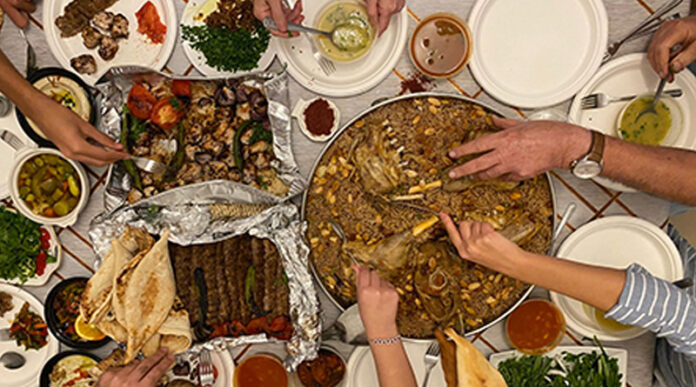
By Hala Nasar
“Ramadan Yajmaeuna,” meaning “Ramadan unites us” in Arabic.
Whether you’re an Arab or live in an Arab country, this is a sentence you hear often during the Holy month of Ramadan.
During Ramadan, Muslim families across countries and cultures join for a time of spirituality, connection and unity.
Six people.
Six Arab and Desi people take me through their Ramadan. A personal invitation into their homes, their hearts and their minds. And most importantly, their dinner table.
It starts at 3 a.m.
When Ted Mosby’s mother in How I Met Your Mother said, “nothing good happens after 2 a.m.,” she clearly didn’t know about suhoor.
Unlike most ominous things happening around 3 a.m., having suhoor with your family before the Fajr prayer is a common peaceful way to start the day during Ramadan.
Brain Masala is a popular street food originating from Hyderabad, India. It is made of cow or goat brain cooked with tomatoes, aromatics, spices like turmeric and green chili, and garnished with ginger and coriander.
Recipe link: https://kfoods.com/recipes/brain-masala_rid922
For Ali Kurukci, a 20-year-old Egyptian-Iraqi, mornings are slow. Similarly, Wajiha Siddiqi, a 20-year-old Pakistani, patiently waits in the kitchen reading the Quran as her mother prepares food at the crack of dawn.
For others, suhoor is highly enjoyable. “After 12 a.m., I feel like the world is so alive. Getting suhoor with my siblings is fun; it’s a lot of laughs and jokes,” said Nada Mohamed, a 19-year-old Egyptian.
While suhoor can be lively, some like a mellow start to their day.
Qutubuddin Siddiqui, a 39-year-old Indian, grew up seeing his father have a banana that was cut and soaked in milk for suhoor.
Years later, that memory of his father remains alive in his kitchen when he has that same exact meal for suhoor.
Food can be an extraordinary tool to connect people wherever and whenever. While accounting for food likes and dislikes in families can be stressful, having family food traditions that are carried throughout generations is a binding experience for life.
Traditions vary in kind and purpose. Some are born out of pure love, like Jawwad Salahuddin’s.
Salahuddin, 47, is a Pakistani father that has Paratha, Brain Masala and Karak Chai with his family every Eid al-Fitr, a family tradition started by his mother. This dish is his personal favorite, the one he looks forward to the most during Ramadan.
Although he looks forward to this dish every Eid, Salahuddin’s favorite Ramadan tradition is having suhoor and iftar with his family at the table.
“In today’s fast-paced life, it feels like a blessing and reason to slow down and have more family time,” he said.
Similarly, Mohamed’s experience with certain Ramadan dishes started with her family in Egypt.
Balaleet is a sweet and savory breakfast dish made with egg and vermicelli and various spices. Reqaq is a type of crispy, paper-thin bread made of whole wheat flour. Dango is boiled chickpeas with spices. Machboos is the most popular Emirati dish, made with rice and lamb, chicken, or fish.
“We have to make samosas and spring rolls every Ramadan, it’s a must. I think they started with my grandparents and now it’s just been passed along to us,” she said.
Mohamed believes iftar in Egypt is extraordinary. It is common to see people lay out long tables for people to join in on the feast. She believes that the way Egyptians share food with one another is a wholesome sight to see.
Some traditions, on the other hand, are born out of hate.
“The most essential thing we have [during Ramadan] is brewing heavy black tea after iftar. My mom started it because she hates settling for lame teabags or powder tea,” said Kurukci.
One of the things that Iraqis are famous for is their black tea. The process begins with obtaining loose black tea leaves and boiling water. Kurukci’s mother then brews the tea leaves for a minimum of one hour to have with dessert.
“This small extra effort defined how we treat the quality of tea in our house, and now it’s the part of Ramadan I look forward to the most; having mom’s chai while watching MBC Iraq,” he added.
While these family traditions are planned and done intentionally every Ramadan, some happen by accident and end up sticking around.
One fateful Ramadan night, Siddiqi’s mother made the traditional set of Pakistani dishes for iftar, with Rooh Afza on the side, a deep pink-colored fruity syrup that can be added to water to make a refreshing drink.
As her mother clamored around the busy kitchen, trying to make sure everything is ready in time for iftar, she decided to add lemon juice to the Rooh Afza, an untraditional addition to the traditional drink.
The moment that Siddiqi and her mother tried the sour Rooh Afza, they decided that the sweet and sour combination created a taste that tickled their senses in an unexpected way.
They agreed that the rest of the family simply must try it.
However, not everybody shared their views on it.
“My sister didn’t like it at all, she thought it tasted too bitter. Ever since then, we always make two different batches of Rooh Afza, one with lemon juice and one without,” she said.
Favorite Ramadan dishes of the six people:
Ali Kurukci: Iraqi dishes such as Kabab, Dolma, Tishreeb, and Iraqi Chai
Wajida Siddiqi: Dhai Baray and fruit chaat
Nada Mohamed: Mom’s spinach and cheese samosas and Qatayef for dessert
Qutubuddin Siddiqui: Boiled lentils and Rooh Afza
Jawwad Salahuddin : Brain Masala, Paratha, Karak Chai
Yousef Gargawi: Qatayef
After all, it appears that iftar unites and separates.
On the other end of the spectrum, some traditions stick around out of necessity.
In 2015, Yousef Gargawi’s family faced a conundrum. The 20-year-old found out that his brother has Celiac disease, an inability to digest gluten. This meant that his brother couldn’t eat most of the beloved Emirati dishes their family had, since traditional Emirati dishes such as Balaleet, Reqaq, Dango and Machboos were rich in gluten.
Since then, the large Emirati family found creative ways to include gluten-free dishes in their Ramadan meals, always ensuring that at least half of the dishes served are safe for his brother’s consumption. This brought the family closer than they expected and allowed them to get creative with the food they eat.
Muslims around the world break their fast during Ramadan with dishes they love and hold dear to their hearts.
However, while iftar is about breaking your fast with food, many think that food doesn’t define iftar.
“There’s no defined way that food shapes futoor. It’s the environment that makes or breaks it. That’s why for my family, it doesn’t matter if we only have soup and dates for iftar, or a big tray of lamb and rice, as long as we made the effort to set the table, sit together, watch tv and drink tea, then futoor was shaped up to be great,” said Kurukci.
Similarly, the mesh of dishes from different cultures can create a harmony that shapes a memorable iftar.
Siddiqi spends some Ramadan nights at her friends’ houses, where they make an effort to experience each other’s cultures through national dishes from several cuisines.
“It’s interesting to see how different the dishes are compared to what my family makes,” she said. “It’s also that much more special when you share them with the people you cherish together.”
To these six individuals from very different yet similar cultures, life is about the little moments.
So, whether it’s dusk or dawn, I implore you, dear reader, to share your food with loved ones. And remember, nothing good happens after 2 a.m., unless it’s suhoor.

















